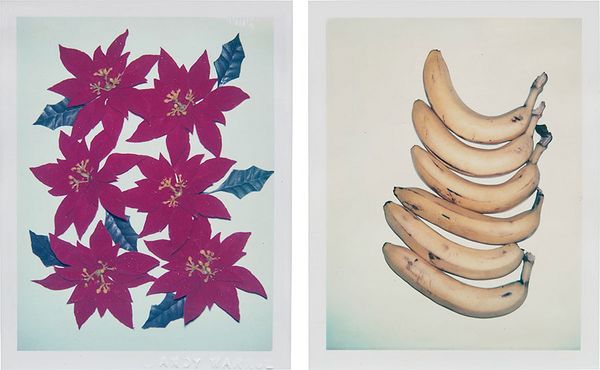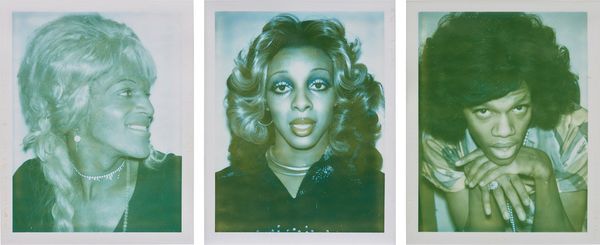Andy Warhol, Five Works: (i) Joan Collins; (ii) Jane Fonda; (iii) Carly Simon; (iv) Karen Kain; (v) Karen Kain, (i) circa 1985, (ii) circa 1980, (iii) circa 1970s, (iv) - (v) circa 1983. New Now London.
Phillips' New Now London Auction on 28 April features a selection of Andy Warhol Polaroid photographs which are being sold as a group from an important private collection. Below, we look at the special history of these works and how they functioned as key references for both the artist's practice and also as precursors of social photo feeds of today.
One of the defining characteristics of today’s modes of communication is obviousness. Our ability to create, collect, and curate photographs through digital forms and apps like Instagram have become so omnipresent that It's difficult to imagine, even for those who remember a world without them, how something so right-there wasn’t already developed. This obviousness, in turn, casts a shadow over earlier iterations and recontextualizes the time before their ubiquity. Nevertheless, this world did exist, and the conceptual basis of what would become these digital interfaces lead back to Andy Warhol and a peculiar Polaroid camera with a knack for capturing the celebrity essence which so obsessed the artist. Warhol’s Polaroids provide a link between his examinations of fame, his factory-like production methods, the intersections of stardom and image, and a look at the artist’s presaging of what we know today as the “plandid” shot.

Andy Warhol, Dracula, 1978-79. New Now London.
Purpose-built for portraits, the Polaroid Big Shot was an eccentric camera with a large flash diffuser and fixed focal distance of only a few feet, requiring Warhol to shuffle back and forth to keep his subject in focus. Brightness was provided by flash cubes, which, combined with the matted makeup his subjects often wore, created a flattened image which would then serve as the foundation for a silkscreen print in Warhol’s production line. Sessions were quick, minimally guided, and likely much more casual than the heavily staged and polished photoshoots his subjects were accustomed to. Recalling a 1979 photoshoot with then-partner Goldie Hawn, Ryan O’Neill noted, “There was no easel, no paint. There was just this strange dentist’s Polaroid camera. He just snapped her at different turns, maybe twenty-five shots. It took longer to do her hair.”

Andy Warhol, Diana Vreeland, circa 1980s. New Now London.
The camera became Warhol’s “pen and paper,” an instrument with which to capture the movie stars, musicians, and New York high-society figures who routinely pilgrimaged to his studio to have their commissioned portrait taken. It is said that Warhol produced nearly one thousand silk-screen portraits between 1971, the year the Big Shot camera was introduced (it would only be in production until 1973), and his death in 1987, placing these photographs at the heart of his output for over two decades and making up what the artist dubbed “one big painting called Portraits of Society.” That these commissions cost $25,000 for the first portrait and $15,000 for each subsequent piece only increased celebrity involvement; to pose for Warhol meant to have an exclusive, personal work of art from the creator, documenter, and interpreter of fame itself.
Warhol’s methods became more refined as his silkscreens took on the mass-production elements of the factory, however the Polaroids retained a forthright quality, something between first drafts and unadorned versions of their end products. Warhol saw them as keepsakes, sequencing each original Polaroid in a photo album, adding dimensions of artifact and memory to the works.

Andy Warhol, Two works: (i) Poinsettias; (ii) Bananas, (i) 1982, (ii) 1978. New Now London.
While portraits formed the bulk of the artist’s more recognizable pieces of this era, Warhol engaged with the themes of his early work just as often: everyday objects, found items in the studio, flowers, fruit, and banal subjects which interspersed with his Hollywood faces much in the way one might scroll through a photo feed today. This analog timeline highlighted the artist’s obsessive documenting of his own life, and rather than seeing the portraits as a means to an end, show just how much Warhol pushed the medium to a wider context through his personal catalogue.

Andy Warhol, Three works: (i) Drag Queen Looking Right with Necklace; (ii) Drag Queen (E.M Studded Shirt); (iii) Chin on Hand, circa 1974. New Now London.
Photography was the basis of Warhol’s practice for many of his paintings and prints, providing the artist with a springboard for large-scale recreations, but it was his relentless documentary style that adapted a simple Polaroid camera into a device for flattening the difference between celebrity and commoner, of instant photograph and legacy image. His subjects became larger-than-life versions of themselves – even if they were already screen sensations – with a small, typically Warholian reminder of their semi-spontaneous, but still brilliantly imagined characters in the form of a Polaroid picture.
Discover More from New Now London >
Recommended Reading
